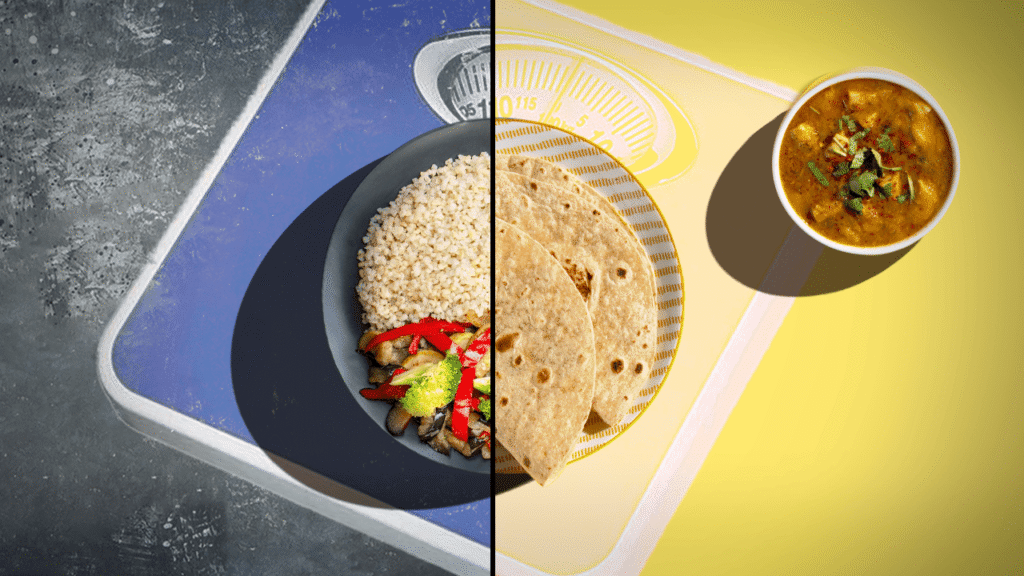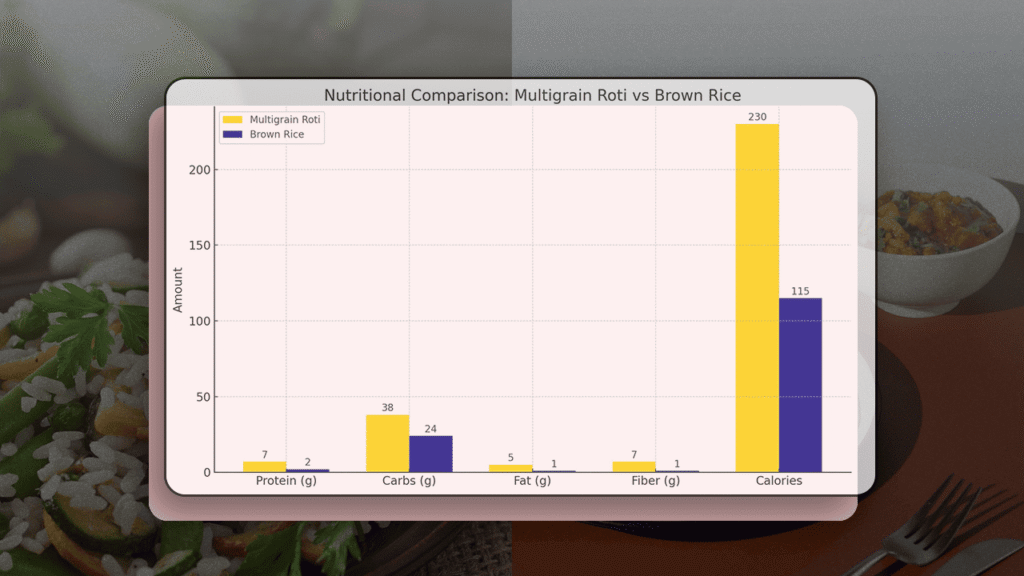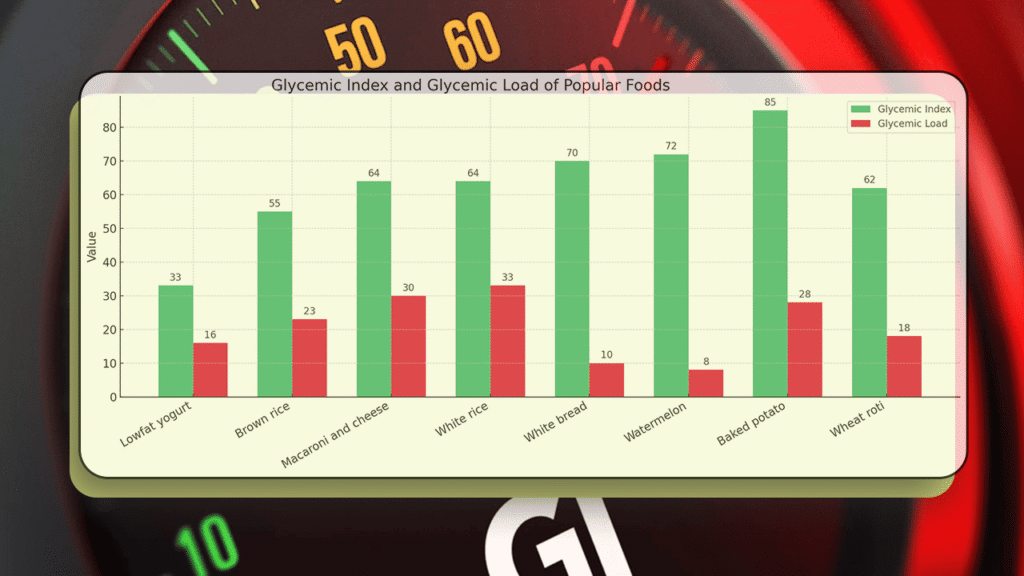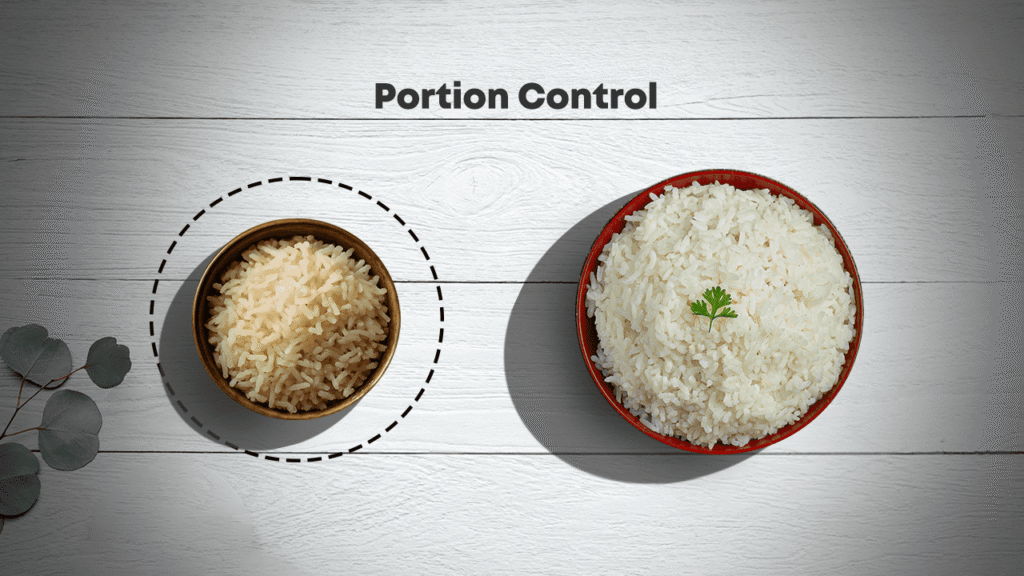Advertisement

- Updated on May 15, 2025
- IST 4:23 am
Picture this: It’s dinner time in a typical Indian household. The aroma of dal and sabzi fills the air, but the real drama unfolds around a simple question—rice or roti? The table splits into two camps, each fiercely loyal to their staple. But when it comes to weight loss, the stakes get higher. Is rice the sneaky villain, or is roti the undercover culprit? Here’s the hook that’s got everyone talking: “Eating roti could make you gain weight faster than rice—truth or myth?” Let’s settle this debate once and for all, with science, stories, and a dash of desi humor.
In this blog, we’ll dig into the calories, fibre, and glycemic load of rice and roti, bust some myths, and share portion control hacks that actually work. By the end, you’ll know which staple is your weight loss ally—and which one’s just pretending. So, grab a seat (and maybe a cup of chai), because we’re about to unpack the great Indian diet dilemma!

The Great Indian Debate: Rice or Roti?
In India, rice and roti are like Bollywood and cricket—everyone’s got a favorite, and debates can get heated. For generations, families have sworn by one or the other, but when weight loss enters the chat, things get tricky. Is rice really the enemy, or is roti secretly sabotaging your diet? Let’s break it down, one chapati and grain at a time.
Calories: Counting the Numbers
First up, the calorie showdown. Calories are the basic math of weight loss—burn more than you eat, and you’re golden. So, how do rice and roti stack up?
- Rice: A cup of cooked white rice (about 150 grams) packs around 200 calories. Brown rice? Slightly fewer, at 180 calories, but with extra perks we’ll get to later.
- Roti: A medium-sized whole wheat roti (30 grams) has about 100-120 calories. But wait—most of us don’t stop at one, do we?
At first glance, roti seems lighter. But here’s the catch: portion sizes. If you’re scooping two cups of rice, that’s 400 calories. Meanwhile, three rotis add up to 300-360 calories. So, rice can be deceptive—one serving looks small, but it’s calorie-dense. Roti, on the other hand, feels more filling, but stack too many, and you’re in the same boat.
Take Rahul, a 25-year-old from Delhi. He switched to rotis to lose weight but ended up eating five at a time. “I thought rotis were ‘light,’” he laughs. “Turns out, I was just eating more!” Lesson learned: calories don’t lie, no matter the staple.

Fibre: The Fullness Factor
Now, let’s talk fibre—the unsung hero of weight loss. Fibre keeps you full, steadies blood sugar, and helps with digestion. So, which staple brings more to the table?
- Rice: White rice is like that friend who promises a lot but delivers little—low in fibre (0.6 grams per cup). Brown rice, though, is the reliable one, with 3.5 grams per cup.
- Roti: A whole wheat roti packs about 2-3 grams of fibre. But if you’re eating maida rotis, you’re back to square one—almost zero fibre.
So, for weight loss, brown rice and whole wheat roti are your best bets. They keep hunger pangs at bay, so you’re less likely to raid the fridge at midnight. Pro tip: Pair them with fibre-rich sabzis like bhindi or palak for a double win.

Glycemic Load: The Sugar Spike Story
Here’s where it gets interesting—glycemic index (GI). GI measures how fast a food spikes your blood sugar. High GI foods can lead to cravings, energy crashes, and yes, weight gain. So, how do rice and roti fare?
- Rice: White rice has a high GI (73), meaning it’s a sugar-spike machine. Brown rice is better, with a medium GI (68).
- Roti: Whole wheat roti has a lower GI (45-55), making it a slower, steadier energy source. But again, maida rotis? High GI (70+), so they’re no better than white rice.
For weight loss, low GI is the way to go. It keeps you full longer and curbs those “I need a snack NOW” moments. So, whole wheat roti edges out white rice here. But wait—there’s a twist. Ever heard of basmati rice? Its GI is lower (50-58), making it a smarter pick than regular white rice. Who knew?

Portion Control: Size Matters
Even the healthiest staple can backfire if you overdo it. Portion control is the secret sauce of weight loss, and both rice and roti need a reality check.
- Rice Hack: Use a small bowl or katori for rice. One katori (150 grams) is about 200 calories—perfect for a meal. And please, no mountain-sized servings!
- Roti Hack: Stick to two medium rotis per meal. If you’re still hungry, load up on veggies, not extra rotis.
Meet Priya, a 30-year-old from Mumbai. She ditched rice for rotis, thinking it was a free pass. But she was eating four rotis with every meal and wondered why the scale wouldn’t budge. “I had to learn that rotis aren’t calorie-free,” she says. Once she dialed it back to two, the kilos started melting.

Real Stories: Triumphs and Traps
Let’s hear from folks who’ve been in the trenches.
- Amit, 22, Bangalore: “I grew up on rice, but for weight loss, I switched to brown rice. It’s nuttier and keeps me full. Lost 5 kg in three months!”
- Sneha, 35, Chennai: “I thought rotis were the answer, but I was eating them with ghee and butter. No wonder I gained weight! Now, I stick to plain rotis with dal.”
These stories prove one thing: it’s not just what you eat, but how you eat it. Rice or roti, the devil’s in the details.
The Verdict: Rice or Roti for Weight Loss?
So, is roti better than rice for weight loss? Drumroll, please—it depends! If you’re team roti, go for whole wheat, limit to two per meal, and skip the ghee smears. If rice is your jam, opt for brown or basmati, keep portions small, and pair with protein and veggies.
But here’s the real tea: neither is a magic bullet. Weight loss boils down to balance, portions, and overall lifestyle. As nutritionist Dr. Anjali Hooda says, “It’s not about banning rice or roti—it’s about making smart choices with both.”
Smart Swaps and Hacks for the Win
Want to level up your staple game? Try these desi diet hacks:
- Mix It Up: Alternate between rice and roti to keep things interesting. Monotony is the enemy of diets!
- Go Multigrain: Experiment with bajra, jowar, or ragi rotis—they’re fibre-rich and low GI.
- Rice Wisely: If you can’t quit white rice, cool it before eating. Cooling converts some starch to resistant starch, lowering its GI.
Portion Plates: Use smaller plates to trick your brain into thinking you’re eating more. It works!
Your Plate, Your Choice
At the end of the day, the rice vs. roti debate isn’t about picking a winner—it’s about finding what works for you. Listen to your body, watch your portions, and don’t fall for myths. Whether you’re team rice or team roti, the real MVP is balance.
So, next time you’re at the dinner table, don’t stress. Enjoy your meal, savor the flavors, and remember: weight loss is a journey, not a sprint. Got a staple story to share? Drop it in the comments—let’s swap tips and cheer each other on!
You May Like This
Advertisement

You May Like This








Advertisement

Advertisement

Advertisement





